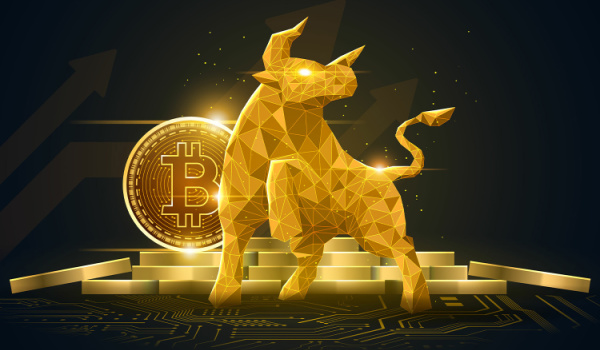By Jahon Jamali | Sarson Funds, Inc.
“Bullish” and Crypto: An Overview
The lion is the king of the jungle. Bulls and bears are the co-regents of the market. If you have ever waded into even the shallowest waters of finance, you may hear two of the first terms: “bull” and “bear.”
So, what do these two seemingly arbitrary animals have anything to do with the financial market? Even more importantly, what does it mean in crypto?
“Bullish” vs. “Bearish”: Comparing Terminology – Where Are These Terms From?
Well, the origin stories of the terms are plenty, but a feasible story of origin comes from the bearskin trade, where the word “bear” pointed to the speculator who intended to sell the stocks to his bearskin.
These “bears” would sell a borrowed stock for a future delivery date in the hopes that the skins would fall and hence would allow the speculator to buy back the stocks at a lower price. From here, the “bulls,” those who predicted otherwise, arose. The bulls would believe that the market would rise and would bet accordingly.
What Is a Bullish Market, and How Are Bullish and Bearish Markets Different?
When these terms get applied to the markets in general, we see the words describing the trends in the market.
Taking from the expectation of the bears for the stocks to drop in price, the term “bear market” became applied to the market that was declining in its vigor, resulting in diminished stock values.
On the other hand, the term “bull market” was applied to the market on the rise, which resulted in increased values for the stocks in the economy.
These terms do not necessarily have to apply to the whole market. The words “bullish” and “bearish” can be descriptors attached to individual market sectors or even to individual financial instruments or institutions to indicate their current trajectory and movement.
What Is a Bullish Market in Crypto?
How does all this apply to crypto?
Simply put, the categories (or animals) of “bull” and “bear” apply in a similar way to cryptocurrency as they do to the traditional instruments in the finance world. In the Web 3.0 world, a cryptocurrency is “bearish” if the trend seems to suggest a movement of the asset down toward the ground, and it is “bullish” if the trend seems to point upwards toward the sky.
What Causes Bullish and Bearish Standard Markets?
It is impossible to precisely determine what causes a market to be a bear market or a bull market. This is because many factors determine the stock market’s direction. The market is often impacted by things like:
- Investor expectations
- Inflation
- Foreign relations
- Increases or decreases in competition
For example, investor expectation is a significant determiner of the bullishness or bearishness of a market.
Even if there are no real problems with a particular company, the stocks of that company may significantly decrease if there is a widely held expectation that the stocks will become of lesser value in the future. This is what would lead to a bearish market. In a way, it is a self-fulfilling prophecy.
On the other hand, even if nothing regarding the product of a particular company has changed, if, for some reason, the investors hear the news that the stock of that company will rise in value, certainly more people will desire the stock and buy up the stock for a higher price. This leads to a bullish trend for that particular company.
The Effect
The effect, if large enough, can be pretty impactful, not only on those specific companies that the investors have thoughts and news about but about the whole industry that the company is involved with.
If a major company’s value increases, investors will likely believe that the value of the stocks surrounding that company’s business and companies similar to that company will also increase in value.
The bullishness that impacts a single major company may significantly affect the entire industry (and surrounding industries) to experience a bullish market. Of course, the reverse can also occur — a bearish company may result in the whole sector becoming bearish.
What Causes Bullish and Bearish Crypto Markets?
The things that make a cryptocurrency market, whether Ethereum (ETH) or Bitcoin (BTC), trend upwards (bullish) or trend downward (bearish) are the same things that give value to the crypto in question.
The things that drive market sentiment (and, thus, market prices) can be investor expectations, supply and demand, the rate of the production of the crypto, the availability of the crypto on the market, competition, and regulations on the cryptocurrency.
For example, we can see that even an unpopular crypto might become much higher in value if the investors think that, for some reason, it might be of great value in the future.
This has happened many times. Sometimes, the bullishness is caused by something as simple as a perception by the public.
Another interesting situation that demonstrates this bullishness from a different perspective is when the rise of cryptocurrency impacted the stock market’s movements.
In 2017, a company merely changed its name from “Long Island Iced Tea Corp” to “Long Blockchain Corp.” The company’s value shot up nearly 300 percent.
However impressive this movement in a single company was, the real lesson here is that this reflected the bullish market that existed underneath this one event. The cryptocurrency sector was on a bullish run.
How Should Investors Respond to Bullish Crypto Markets?
How should investors respond to bullish crypto markets?
In such a market, investors should be careful to adopt a bullish attitude toward buying digital assets. It is not always wise to believe that the crypto will continue to rise and buy up crypto, thinking you are only gaining future revenue.
The reality is that what rises will almost always fall — whether slowly or quickly. The investor must be careful to have a conservative trading strategy, considering the entire movement of the market into account.
During a downturn, whether short-term fluctuations or longer periods of volatility, investor confidence and market conditions are not metrics to be ignored. Crypto traders should be reticent to express too much excitement about uptrends in a bull market and falling prices. They should be even more cautious about pouring money into the market.
Perhaps, in such markets, determining a price at which you promise yourself to sell crypto assets is not a bad technique.
Should Crypto Investors Adopt Bearishness as a Default?
So, does this mean the investor should always have bearishness as a default? This also is not necessarily wise as this would not consider the actual trends around us.
We cannot advise without recognizing the real environment of the market. During a bull run, you don’t want to operate as though the market were displaying bearish trends.
Takeaways
It is essential to understand trends in the market if you are a diligent investor who wants to know the next logical move to make for the most optimal investment of your hard-earned money. The term “bullish” is a helpful word for summarizing the upward trend of a market.
The same term is used in crypto to indicate the value of crypto moving up or down. Knowing what these terms mean so that you may adequately interpret the market is critical in moving your crypto around.
Learn More at American Crypto Academy
Article Sources:








